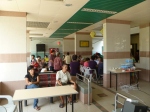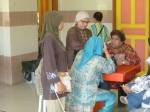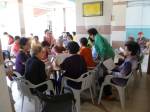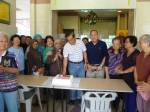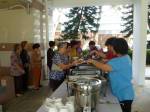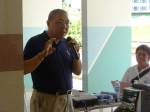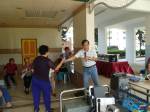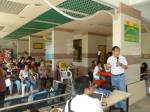In 2010, my family celebrated the first birthday of my first granddaughter, Isabelle. Last month, we celebrated another of our granddaughter, Micaela’s one year old birthday at Changi Chalet.
Many guests, my daughter’s friends from the “mama” club and her former classmates, my son-in-law’s colleagues, my wife’s brothers and sisters and their families and my own siblings, nephews and nieces turned out in full force. The one year old birthday party was also a perfect platform for gathering of kins, relatives and friends. We don’t meet often in view of our busy daily schedules or perhaps the lack of occasions to meet. Therefore, any celebration would be an opportunity to gather around the table for kinship, friendships and of course food and drinks. Though I am not a serious “drinker”, for such occasions, I may drink but exercising self-control to remain sober and a responsible individual.
Back to the one year old birthday party. My daughter, Florence, planned for the party since the beginning of 2013. My daughter planned a Hawaiian theme birthday party as she would like to give Micaela an unforgettable birthday. Unforgettable for a one year old? Yes, at least to capture in photographs. She purchased raffia to make hula skirts, made purchases from USA to decorate the chalet into a Hawaii theme which she said cost much less than in Singapore, made and buy goodies for kids in attendance, prepare food and many preparations relating to the Hawaii theme birthday party. Even my youngest daughter pit in to help her to draw two Hawaiian lady in the usual grass skirts. Finally, my youngest daughter drove my car with Florence to Parkway Parade to pump up balloon with helium, my car was full of balloons when they returned to the chalet. All preparations were completed in good time before the guest turned up less the coconut trees which in the plan should be part of the decoration but were not available as we could not simply chopped down coconut trees. So there was no coconut tree but the party went on as planned.
On Micaela, she is adorable and she smiles whether she hears her name is being called. She likes to play and would initiate contact with people near to her by touching them or pulling their clothes. Whenever, people react to her, she would smile or burst into laughter. She is also responsive to people who speak to her and her eyes would focus on the people who play with her. At her age, Micaela is able to make sounds like “papa”, “mama”, “grandpa” and “grandma” and “jie jie”. For a one year girl, making sounds is fast for age. She could even walk few steps on her own without assistance. I could sense from her expression of joy or relief whenever she completed walking a few steps. In the weeks to come, she would be walking perhaps on her own but to my wife, she would still carry her as long as she could. My wife’s philosophy is “children grow up fast and it would be a lost opportunity and they grow up they would not want to be carried” That explained why my wife and I always carry both of them whenever we are out with them. I thought my wife’s philosophy is practical as once they grow up, they would like to have their own privacy. Therefore, treasure the present and seize the opportunity to do what it right and enjoy their company.
These days children are smarter and tech savvy unlike children of my time where we only learned Alphabets in Primary One level but now they would have learnt these alphabets even before they turn 3 or may be earlier. Thanks and no thanks to their “kia su” parents and my daughter is one of them. Micaela is currently enrolled into a learning class…well my daughter’s ideal of education to start first especially Micaela is born in the year of Dragon. During the birthday party, these young toddlers were lined up for a photo shoot and there were 5 “dragon toddlers”. Besides Micaela, I have another “dragon” grand-nephew and niece.
 Dragon is a mythical animal which the Chinese believe to be an auspicious animal and anyone born under this Chinese zodiac sign has these traits of power but benevolent, wisdom, strength, luck and longevity. No wonder, whenever it comes to the Dragon year, Singapore would have more babies that other Zodiac years. But the catch is these children would have to compete among their cohort for many things in life to be a phoenix or for the male, a dragon.
Dragon is a mythical animal which the Chinese believe to be an auspicious animal and anyone born under this Chinese zodiac sign has these traits of power but benevolent, wisdom, strength, luck and longevity. No wonder, whenever it comes to the Dragon year, Singapore would have more babies that other Zodiac years. But the catch is these children would have to compete among their cohort for many things in life to be a phoenix or for the male, a dragon.
Like the one year old birthday celebration for Isabelle, besides the usual food galore, there were BBQ too. Well, my son and his friend became the BBQ chefs preparing food for our guests. There were so much BBQ food leftover and we continue the family’s BBQ later in the evening and continue to the next day when we had BBQ dinner.
I have not written any blog since Dec 2010 and it is difficult to start. In view of Micaela’s birthday party, my wife put in this request….write a blog for Micaela. Her rationale was since I had written a blog for Isabelle when she was one year old, I should also blog for Micaela and to blog in wordpress too. Sound reasonable to ensure both my granddaughters read what their grandpa had written about their one year old party when they grow up one day.
I guess with my daughter’s focus, soon both my grand daughters would be equipped with the functional skills of literacy and numeracy. They would be able to read what I have written on my thoughts many years ago including my 98 other blogs in 2010.
I look forward to the day when both my grand daughters could engage her grandmother and I. Perhaps, one day when my wife and I retire for good, we would have more time with them. Our wish is for them to grow up into a responsible citizens contributing to the well being of mankind in whichever way they feel comfortable with.
















